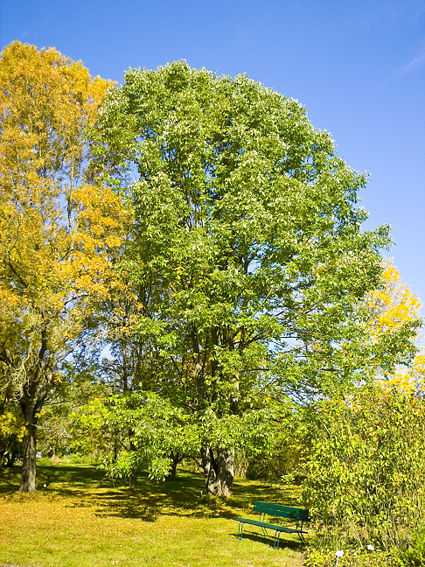Fraxinus americana
| Fraxinus americana | |
|---|---|
 | |
| Scientific classification | |
| Kingdom: | Plantae |
| (unranked): | Angiosperms |
| (unranked): | Eudicots |
| (unranked): | Asterids |
| Order: | Lamiales |
| Family: | Oleaceae |
| Genus: | Fraxinus |
| Species: | F. americana |
| Binomial name | |
| Fraxinus americana L. | |
 | |
| Natural range of Fraxinus americana | |
Fraxinus americana (white ash or American ash) is a species of Fraxinus native to eastern North America found in mesophytic hardwood forests from Nova Scotia west to Minnesota, south to northern Florida, and southwest to eastern Texas.[1]
Characteristics
The name White Ash derives from the glaucous undersides of the leaves. It is similar in appearance to the Green Ash, making identification difficult. The lower sides of the leaves of White Ash are lighter in color than their upper sides, and the outer surface of the twigs of White Ash may be flaky or peeling. Green Ash leaves are similar in color on upper and lower sides, and twigs are smoother. Also, these species tend to occupy different habitat niches, with White Ash found in moist upland sites and Green Ash in wet forests of floodplains or swamps, although there is some overlap in habitat distribution.[2][3]
Cultivation and uses
White ash is one of the most used trees for everyday purposes and, to keep up with high demand, is cultivated almost everywhere it can be. The wood is white and quite dense (within 20% of 670 kg/m3),[4] strong, and straight-grained. It is the timber of choice for production of baseball bats and tool handles. The wood is also favorable for furniture and flooring. Woodworkers use the timber mainly for internal uses due to high perishability in contact with ground soil.[4] It is also used to make lobster traps. Recently, it has also become a popular choice for solidbody electric guitar wood as well. It makes a very servicable longbow if properly worked. The wood was used in ceiling fan blades from the 1970s through the mid-1980s, though cane was sometimes simulated with plastic then. It is no longer used for ceiling fan blades in most countries.
The tree has a mast crop every 11 years and is very easy to plant and cultivate with a survival rate of 30%.[citation needed]
It is widely grown as an ornamental tree in North America as well. Cultivars selected for superior fall color include 'Autumn Applause' and 'Autumn Purple'.
Other names occasionally used for the species include Biltmore ash, Biltmore white ash and cane ash.
Emerald ash borer
The emerald ash borer (Agrilus planipennis or Agrilus marcopoli and EAB) is a green beetle native to Asia.
In North America the borer is an invasive species, highly destructive to ash trees in its introduced range. The damage of this insect rivals that of Chestnut blight and Dutch Elm Disease.[5] To put its damage in perspective, the number of chestnuts killed by the Chestnut blight was around 3.5 billion chestnut trees while there are 3.5 billion ash trees in Ohio alone. Dutch Elm Disease killed only 200 million elm trees while EAB threatens 7.5 billion ash trees in the United States. The insect threatens the entire North American Fraxinus genus, while past invasive tree pests have only threatened a single species within a genus. Since its accidental introduction into the United States and Canada in the 1990s, and its subsequent detection in 2002, it has spread to eleven states and adjacent parts of Canada. It has killed at least 50 million ash trees so far and threatens to kill most of the ash trees throughout North America. The green ash and the black ash trees are preferred. White ash is also killed rapidly, but usually only after green and black ash trees are eliminated. Blue ash displays some resistance to the emerald ash borer by forming callous tissue around EAB galleries; however, they are usually killed. White ash has been less affected by emerald ash borer due to its small population (unlike its cousin, F. americana is not commonly seen in cultivation) compared to Green ash, which was planted in huge numbers as an ornamental.[citation needed]
See also
References
| Wikimedia Commons has media related to Fraxinus americana. |
- ↑ Germplasm Resources Information Network: Fraxinus americana
- ↑ Common Trees of the North Carolina Piedmont: Fraxinus americana
- ↑ New Brunswick tree and shrub: Fraxinus americana
- ↑ 4.0 4.1 White Ash, Niche Timbers. Retrieved on 2009-07-24.
- ↑ Bruce Schlink (2012). Americans Held Hostage by the Environmentalist Movement. Dorrance Publishing. p. 494.
Sources (some not Wikified)
- US Forest Service (accessed 19 January 2009)
- Emeraldashborer.info
- Isa-Arbor.com